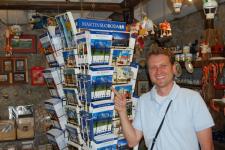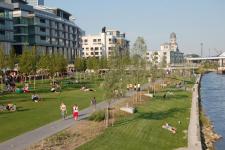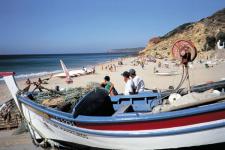One of the big surprises of my travels this summer has been Bratislava, the capital of Slovakia. Bratislava sits on the Danube less than an hour’s train ride from Vienna, and a short hop from Budapest. A desolate ghost town just a few years ago, today Bratislava is arguably the fastest-changing city in Europe.
 |
|
Enlarge photo
|
 |
|
Enlarge photo
|
I spent a day visiting Bratislava with Martin Sloboda, a local tycoon of a guide (www.msagency.sk). He writes the town’s dominant guidebook (on sale at spinning racks in nearly every shop in town), shoots the photos for postcards (on the next spinning rack), organizes the visits of the luxurious Tauck tour groups when their Danube cruise ships dock in town, and is the local tourist board’s choice for an escort when a VIP visits. He’s a fine example of the youthful energy and leadership responsible for the success story of Slovakia.
Martin explained to me why people who were between 15 and 25 in 1989 are most successful today, and the leaders of Slovakia. Throughout the communist period and in post-communist Czechoslovakia, there was no real political diplomatic class among Slovaks (because Czechs dominated Czechoslovak government). But when Slovakia peacefully split off from the Czech Republic in 1993’s “Velvet Divorce,” many young Slovaks returned from the West and quickly took the helm, filling that void. Today Slovakia’s wealthy class is about 40 years old, largely free from the old boys’ network (most of whom stayed in the Czech lands). This trend played out in recent election, where for the first time, no former communist was sent to government (unique in Eastern Europe). The new “Dream Team,” as many locals call the people in power now now, is liberal on social issues but realistic — decidedly not populist — on economic issues, as if inspired by the Greek fiasco (in fact, Slovakia has opted not to give bailout money to Greece).
Spending a day with Martin to update our Bratislava chapter, I was able to fine-tune our existing coverage. I also picked up lots of new ideas. Here’s an example of the kind of raw material I came away with, most of which I hope to massage into our existing chapter to make its coverage more complete:
The Danube divides Europe’s two biggest mountain ranges: the Alps of Western Europe, and the Carpathians of Eastern Europe. Slovakia (and Bratislava is particular) has long been a bridge between East and West.
When Budapest was taken by Ottoman Turks in the 1500s, the political and religious elite of Hungary retreated to Bratislava — far from the Ottomans and close to Vienna, but still within greater Hungary, at an easy-to-defend location on the Danube. Bratislava hosted 19 coronations between 1563 to 1830. In fact, the last Hungarian coronation was not in Budapest, but in Bratislava.
In 1760s, the Ottoman threat was gone, and the strategic military importance of Bratislava was over. Habsburg Empress Maria Theresa needed a comfy palace. She wanted her daughter Christina to stay close, so she made her son-in-law Albert the Viceroy of Hungary so that they’d set up here. That’s why Bratislava has a fine Habsburg palace and a strong Vienna connection.
A third of the Slovak population emigrated to the US between 1880 and 1914. There were lots of deserters during World War I — opting to fight against rather than with Hungary. Even today, Hungarians lament loss of their old capital, Bratislava, from the post-World War I Treaty of Trianon. Meanwhile, you could say that historic Hungarian cultural oppression of the Czechs and Slovaks led to the creation of modern Czechoslovakia, as those smaller groups sought safety in numbers after World War I.
The United States has long been a big supporter of Czechoslovakia. Between the world wars, Czechoslovakia was the only democracy and had the best economy in this part of Europe.
Because of its location nearly on the border with Austria (and the West), Bratislava has many bomb shelters, built during the tense times around the Cuban Missile Crisis. Today these make ideal venues for clubs — right in the town, but powerfully soundproof.
Why is it hard to think of any great Slovaks? During the time of Czechoslovakia (1919-1993), every time a Slovak excelled in culture or politics or sports, they were considered “Czech” by the rest of the world. (For example, the leader of the 1968 Prague Spring uprising against the Soviets, Alexander Dubcek, was actually Slovak.) As of 1993, suddenly Slovaks could celebrate their own heroes without the confusion.
Bratislava was a damaged husk from after World War II until the end of communism in 1989. The communist regime cared only for the future — they had no respect for town’s heritage. In the 1950s, they actually sold Bratislava’s original medieval cobbles to cute towns in Germany that were rebuilding with elegant Old World character after World War II.
With the fall of communism in 1989 began a nearly decade-long process of restitution: The government needed to sort out who had rights to the buildings, and return them to their original owners. During this time, little repair or development took place (since there’s no point investing in a property until ownership is clearly established). It’s hard to imagine today that as recently as the 1990s, Bratislava’s old center was basically a dangerous ghost town.
By 1998, ownership had finally been sorted out, and the Old Town was made traffic-free. Bratislava has been reborn — life has returned with a vengeance in the last decade. The only decrepit buildings left in Bratislava are run-down only because they still have ownership issues.
Slovakia’s huge armaments industry collapsed after communism, leaving it in quite a deep economic hole. But the country’s central location — with 300 million consumers living within a day’s truck drive — is ideal for industry. It didn’t take long for the gap left by armaments to be filled by carmakers. Today Slovakia, with five million people, produces one million cars a year. That makes them the world’s top car producers, per capita. Its business environment and relatively unregulated employment code make it easy to hire and easy to fire employees — which is good for business. Strikes don’t plague the country.
While the rural parts of the country have dismal unemployment rates, Bratislava has only 2.5 percent unemployment. The measure for standard of living as it relates to local costs puts Bratislava at #10 among European cities. Among post-communist nations, only the Slovaks and the Slovenes have the euro, with Estonia on deck. This is testimony to the wise economic policies the Slovaks have chosen, rather than the populist sweet talk and promises so common elsewhere.
Slovak kids have incredible opportunity — unprecedented in this nation’s history. Because of the EU’s Erasmus program, Slovak young people can apply to universities like Cambridge, and be treated like a Brit. And yet, many choose to stay right here. Bratislava at night is lively; the very young center thrives. While it has lots of university students, there are no campuses as such — so the Old Town is the place where students go to play.










